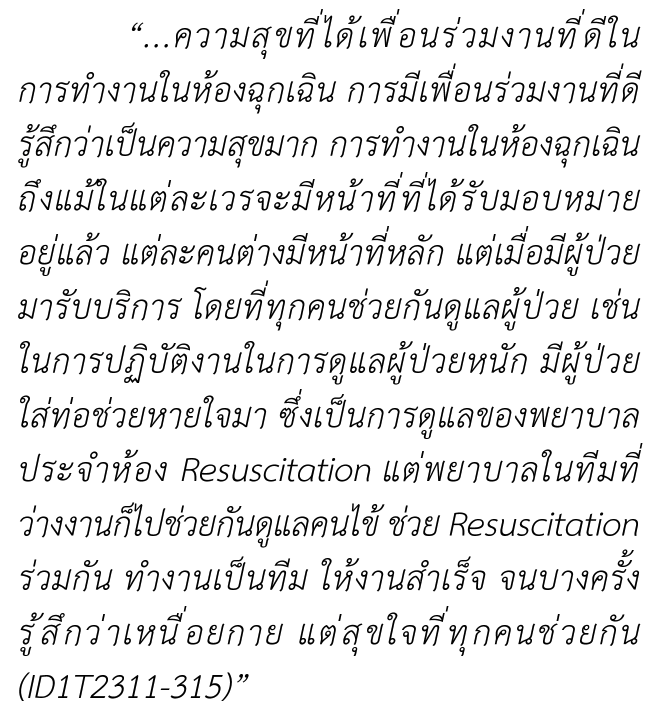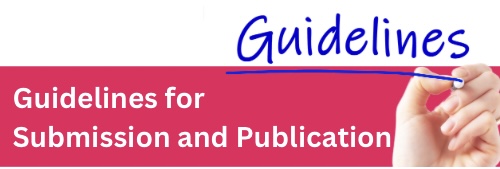WORKING AS A NURSE IN AN EMERGENCY UNIT AT A GENERAL HOSPITAL
Keywords:
registered nurses, emergency unit, phenomenologyAbstract
The purpose of this study was to describe the experiences of team mentors mentoring nurses working in the Emergency Unit. The qualitative research methodology of Heidegger's interpretative phenomenology was employed. Twelve registered nurses with at least 2-year experience in Emergency department work were included. Data were collected through in-depth interviews, voice recordings, field notes, and observations. The data were transcribed verbatim and then analyzed using the interpretative method proposed by Crist and Tanner, ensuring trustworthiness based on the criteria of Guba and Lincoln.
The findings related to experiences with a team mentor could be categorized into eight themes as follows: 1) Screening patients requiring diverse skills, 2) Monitoring symptoms to determine admission or discharge, 3) Assisting in resuscitation and expediting procedures, 4) Referring patients, 5) Providing emergency medical services, 6) Offering disaster services, 7) Performing other assigned tasks, 8) Taking the results from work. The results of this study gain an understanding of the variety of tasks of registered nurses in the Emergency Department. Registered nurses care for patients of all diseases and ages, including all levels of treatment urgency. Therefore, they must have a wide range of medical knowledge and skills to be able to evaluate, diagnose, and provide nursing care appropriately and quickly.
Downloads
References
Ahwal, S., & Arora, S. (2015). Workplace stress for nurses in emergency department. International Journal of Emergency & Trauma Nursing, 1(2), 17-21.
Annoppornchai, V., & Kidhirunkul, C. (2021). Applications of telemedicine systems for the improvement of quality service in rural emergency medicine. Western University Research Journal of Humanities and Social Science, 7(3), 258-271.
Alomari, A. H., Collison, J. J., Hunt, L., & Wilson, N. J. (2020). Stressors for emergency department nurse: Insights from a cross-sectional survey. Journal of Clinical Nursing, 30, 975-985.
Bureau of Nursing. (2008). nursing standards in hospital (3rd ed.). Bangkok: The War Veterans Organization.
Chomjan, T., & Pachakawe, M. (2020). Process and Outcomes of cardiopulmonary resuscitation in the intensive care unit. APHEIT Journal of Nursing and Health, 2(3), 16-32.
Channuan, A., & Prachusil, K., (2010). A study of emergency medical services nurses’ competency, community hospitals. Journal of The Royal Thai Army Nurses, 11(1), 24-29.
Crist, J. D., & Tanner, C. A. (2003). Interpretation/analysis methods in hermeneutic interpretive phenomenology. Nursing Research, 52(3), 202-205.
Deelertpaiboon, S., Mamuangbon, J., Tangkulpithaporn, S., Kunkunadet, K., Thanakornpornsawat, A., Vannavijit, J., & Oumtanee, A. (2023). Digital literacy development of professional nurses. Vajira Nursing Journal, 25(1), 70-79.
Department of Medical Services and Thai Association for Emergency Medicine. (2017). emergency operations team development course tertiary medical. Nonthaburi: Ministry of Public Health.
Department of Medical Services. (2018). MOPH ED, Triage (2nd ed.). Nonthaburi: Department of Medical Services.
Department of Medical Services. (2018). Guideline for er service delivery. Nonthaburi: Department of Medical Services.
Department of Medical Services. (2020). Guidelines for emergency care of patients in the situation of the outbreak of COVID-19. Nonthaburi: Department of Medical Services.
Guba, E. G., & Lincoln, Y. S. (1989). Fourth generation evaluation. Newbury Park, CA: Sage.
Jantarapon, K., Boonyoung, N., & Thongsuk, P. (2020). Personnel risk and personnel risk management of head nurses, as perceived by registered nurses in emergency rooms in general hospitals of southern Thailand. The Southern College Network Journal of Nursing and Public Health, 7(1), 240-253.
Muneerat, S. Suwannapong, N., Tipayamongkholgul, M., & Manmee, C. (2019). Job characteristics, job-related stress and intention to stay in professional nursing in a tertiary care hospital, ministry of public health. Journal of Health Science, 28(1), 133-141.
Muneesawang, P. (2018). Naresuan university: Project to improve the quality of emergency medical services: Phitsanulok, long-distance in rural areas through high-speed digital networks.
National Institute for Emergency Medicine. (2013). Emergency medical triage protocol and criteria based dispatch. Nonthaburi.
Sitthipracharaj, J. (2017). Role of emergency nurse practitioner during disaster. Vajira Nursing Journal, 19(2), 1-12.
Sripakho, P. (2014). Professional nursing development: developing nursing leadership. Journal of The Royal Thai Army Nurses, 15(3), 1-8.
Somboon, J., & Oumtanee, A. (2012). Experiences of professional nurses working at emergency medical services. Vajira Nursing Journal, 14(2), 17-28.
Pitaksa, P., Sirichotiratana, N., Wirin, K., & Sumonchat, D. (2020). Nursing professional’s work-life balance in an autonomous university hospital. Public Health Policy and Laws Journal, 6(Supplement), 83-93.
Pumput, P., & Puriwitthayatira, K. (2022). The effects of simulation-based learning for preparation of mental health and psychiatric practicum in nursing students. Nursing, Health, and Education Journal, 5(3), 37-46.
RamKaew, K., & Oumtanee, A. (2014). Working experience of emergency nurse in tertiary care hospital. Journal of The Royal Army Nurses, 15(3), 226-234.
Rattanasunya, P. (2021). Developing acute ischemic stroke fast track to minimize the time required to perform CT brain in ChaoPhya Abhaibhubejhr hospital. Region 11 Medical Journal, 35(1), 63-77.
Thiangtham, W. (2005). Phenomenology. Pragai Jirojanakul in Nursing research: Concepts, principles and process. Bangkok: Thanapress.
Wongjumpoo, P., Muangcheun, S., & Aiumchai, K. (2022). Development of emergency medical service management model in emergency patient referral for situations the epidemic of coronavirus disease 2019 in Phayao province. Journal of Social Science for Local Rajabhat Mahasarakham University, 6(2), 231-239.

Downloads
Published
How to Cite
Issue
Section
License
Copyright (c) 2023 JOURNAL OF THE POLICE NURSES

This work is licensed under a Creative Commons Attribution-NonCommercial-NoDerivatives 4.0 International License.
ผลงานที่ได้ตีพิมพ์แล้วจะเป็นลิขสิทธิ์ของวารสารพยาบาลตำรวจ














